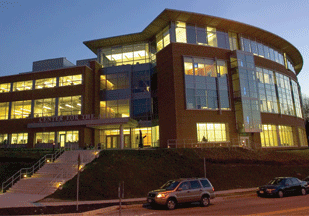
Project Profile Towson University
Featured Products:
- NOTI-FIRE-NET intelligent fire alarm network
- ONYXWorks graphic workstation
TOWSON UNIVERSITY IN TOWSON, MARYLAND
Time is of the essence when disaster looms. Weather-related tragedies and terrorist activities of the past decade have created increased demand from public and private stakeholders for a reliable means of communicating critical information to large groups of people. This mass notification concept has received heightened attention from facilities personnel particularly in the military, educational and commercial/industrial sectors.
SYSTEMS ASSESSMENT AND RISK ANALYSIS
According to Paul Parrish, Towson University’s environmental health and safety officer, “The issue of mass notification came up at Towson when someone asked how we can expect to communicate with students and staff in an emergency.”
Towson University encompasses more than 40 buildings, covering 328 acres within the town of Towson, 15 minutes outside of Baltimore.
“When weapons of mass destruction or the possibility of a hazmat incident came up, we had to ask ourselves if we could realistically notify the staff and student population of an emergency situation in time to make a real difference,” says Parrish.
Towson’s initial emergency communications solution comprised a text messaging system used to alert students, staff, parents and others. While such alerts proved to reach a good portion of Towson’s population, university officials understood it was not a comprehensive solution.
“We also have an outdoor public address system consisting of five [speaker] towers. University Police recently installed them on select buildings to provide adequate campus-wide coverage,” says Parrish. “But we realized that this was not enough. We also needed mass notification inside our buildings.”
The university already had standalone fire alarm EVAC (emergency voice/alarm communications) systems in half of its buildings. However, these systems operated independently, requiring users to be located within each building to activate communications.
Looking for guidance, Parrish approached the school’s current fire protection contractors, Fireline Corporation. “I asked Fireline’s project manager, Mark Reedy, if there was any way to connect these EVAC systems together so we can make announcements from a single location on campus. He looked into the technical details and came to the conclusion that it could be done,” says Parrish.
INTEGRATED, ECONOMIC APPROACH
Per Towson’s specifications, Fireline worked to design a combination fire alarm/MNS with one point of monitoring and control. Making use of the individual fire alarm EVAC systems succeeded in saving the school a substantial sum of time and money. “Reedy’s firm installed the in-building MNS systems we needed, which also are part of our campus-wide fire alarm system. Where the police department is responsible for the outdoor speaker system, I'm responsible for the mass notification/fire alarm system,” says Parrish.
Twenty of the schools’ buildings are equipped with NOTIFIER EVAC systems featuring standard pre-recorded messages and microphones for authorized users to provide real-time announcements. Systems in seven of the buildings categorized as high-rises also include firefighter phones that enable first responders to communicate directly with each other.
Currently, Fireline is upgrading the remaining school buildings to include ONYX Series EVAC systems from NOTIFIER. Once complete, all buildings’ systems will feature both fire alarm and mass notification protection, all of which will be tied together for centralized, campus-wide control.
In retrofit applications similar to Towson, capitalizing on the strengths of existing fire alarm communication and notification technology can deliver intangible benefits not common to alternative MNS offerings:
- Supervision – These systems are self-monitoring, meaning immediate alerts are sent to central monitoring station personnel any time an issue that could compromise system functionality is detected (i.e. loose wire, detector tampering, etc.).
- Survivability – Many of today’s fire alarm network technologies comprise distributed intelligence, which can help to assure functionality during a catastrophic event. As a result, if one part of the network is damaged, the remaining components continue to operate properly.
- Intelligibility – Clarity of communications is critical (indoors and outside) increasing speaker volumes can many times distort the message. Proper MNS design takes background noise, room size and acoustics into consideration, while incorporating visual notification such as LED signage and special-colored strobes.
- Testing Requirements – Per NFPA (National Fire Alarm Association) code, all commercial fire alarm systems, in both public and private facilities, are to be tested and properly maintained on a semi-annual basis. Failure to do so typically results in the loss of occupancy permits.
SYSTEMS UNIFICATION AND CONTROL
Utilizing NOTI-FIRE-NET network technology, Reedy has been able to tie together new and existing EVAC systems throughout the campus. Connectivity between individual buildings has been accomplished using the university’s existing, campus-wide Ethernet network—another considerable cost saver.
A NOTIFIER ONYXWorks graphic workstation located at the university police department provides school officials with a common point of command and control. Here, campus security and safety personnel can view all system events and maintenance alerts as well as issue critical instructions to specific areas or groups of buildings. Much like a public address system, this central workstation also allows for day-to-day announcements to be made.
Towson’s campus-wide network facilitates easy integration of similar systems during future campus expansions. The Internet’s worldwide reach make it possible for Towson to connect and control other fire alarm/MNS on a local, regional and global basis.
Evolving building codes and public expectations continue to pressure for better, more comprehensive MNS within all facility types. It’s important for security directors and others in positions of responsibility to consider future MNS needs prior to performing a major building systems renovation, especially when upgrading fire alarms.
According to Parrish, “It’s better to upgrade to EVAC technology now, as opposed to traditional horns. So when mass notification is needed, the transition will be smooth and cost effective.”